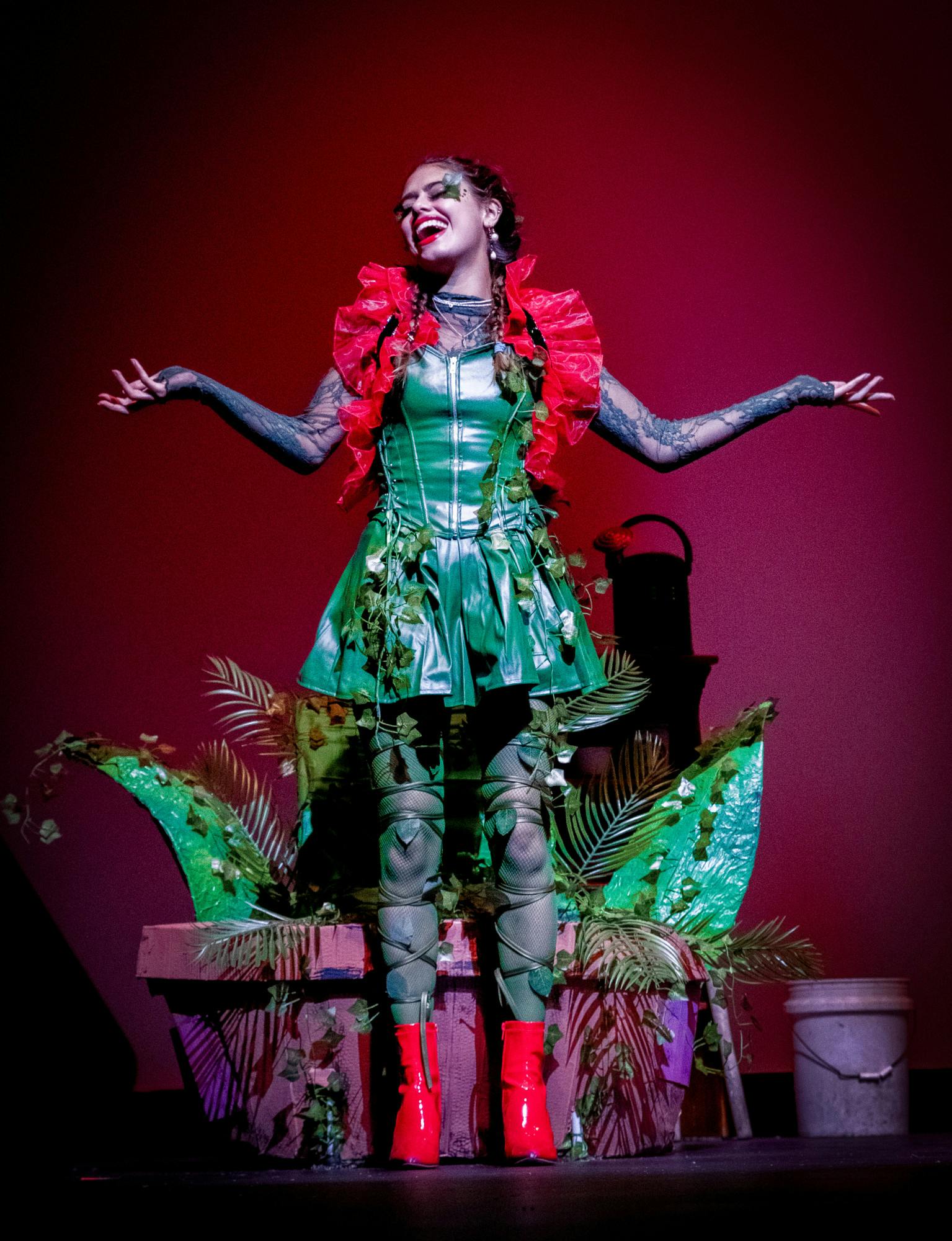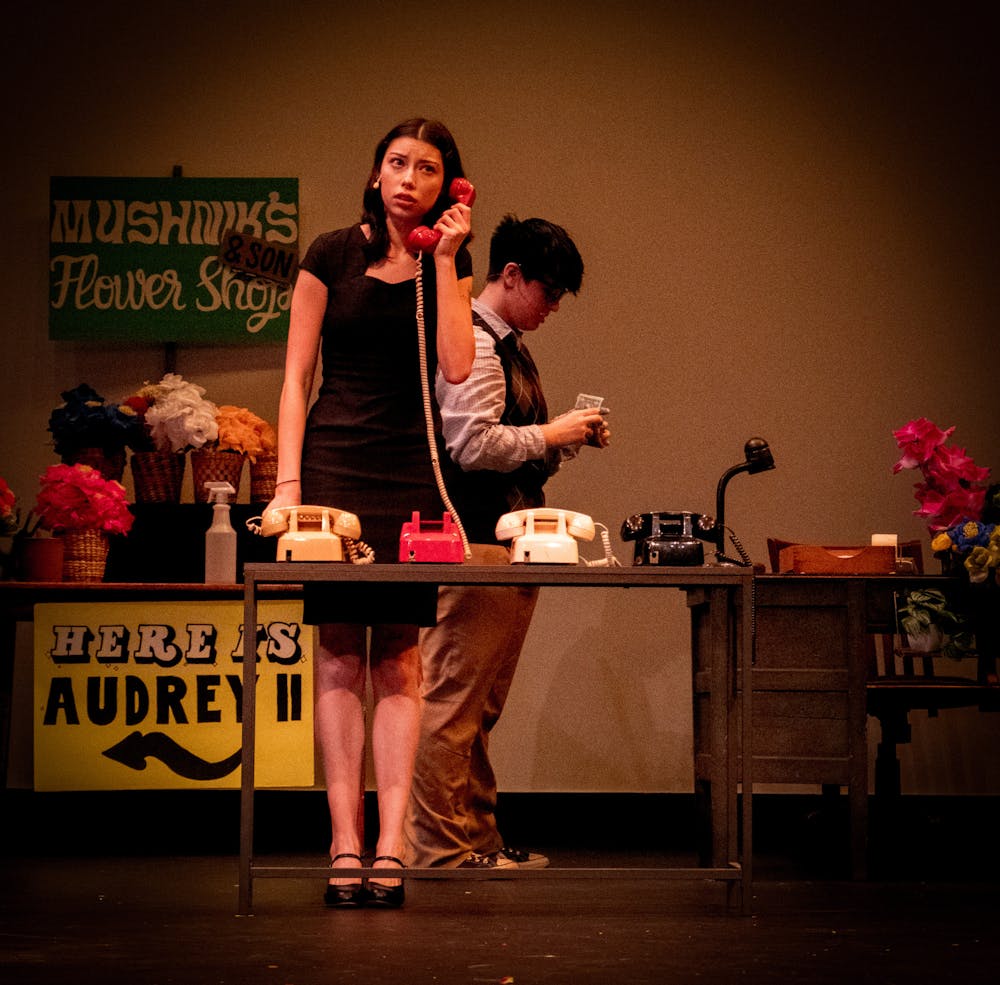A perfectly spooky end to the Halloween season, Middlebury College Musical Theatre’s fall production of “Little Shop of Horrors” ran at the Town Hall Theater (THT) for three consecutive nights, thrilling audiences with its blend of humor, emotion and terror.
“Little Shop of Horrors”, a horror-comedy rock musical, is loosely based on a 1960 black comedy film by the same name, featuring music by Alan Menken with lyrics and storyline from Howard Ashman’s novel. Menken’s music, with its diverse mix of rock and roll, Doo-wop, and early Motown, creates a fast-paced, vibrant atmosphere, expertly presented by the talented student actors of Middlebury College Musical Theatre (MCMT).
MCMT is Middlebury’s entirely student-run musical theater group, which handled every element of production — from singing and acting to design and direction. Each semester, they produce a new piece that showcases the talent, professionalism and passion of Middlebury students, never ceasing to amaze audiences. “Little Shop of Horrors” was no different.
The musical tells the peculiar story of Seymour, a timid flower shop assistant who discovers an unusual plant that he names “Audrey II” after his crush. This strange plant brings fame and fortune to the struggling shop, but at a terrible cost: Audrey II is carnivorous, feeding on human flesh and blood. As the plant demands more human sacrifices in exchange for Seymour’s success, Seymour faces a moral dilemma, forced to weigh his ambition against his conscience. The musical, with its whimsically loose logic, explores the universal themes of ambition, love and the lengths one might go to achieve their dreams.
Notable directorial choices by Jonathan Mount ’25.5 brought the production to life. Despite operating on a relatively small stage, the actors and directors utilized the space to its maximum, employing curtains for smooth scene transitions and cleverly defining different locations. Even the actors themselves were used to their fullest potential.
Quinn Donaldson ’26.5 was charged with playing a multitude of different minor characters, which prompted laughter as the audience marveled at his impressive versatility. Moreover, the lighting is exceptional, changing in accordance with Seymour’s inner turmoil. Blue lighting signals Seymour’s solitude and heightens his touching performance. And when Audrey II awakes blood-thirsty, a sinister and pulsing red light bathes her green silhouette; the sharp contrast of colors adds to the scene’s emotional tension as she savagely devours her victims.
Additionally, the costumes, especially those of Audrey II, are worth recognition. The plant evolves from a small plant in a pot played by a hand puppet, to a full-grown woman played by Gabriela Rosen ’26 whose attire upgrades each time she feasts. Rosen had vine-like makeup and braided hair to emphasize her character. Her clothing begins as a rather simple green dress stained with red and embroidered with leaves, and then later transforms into a somewhat Victorian nightgown-esque green dress with a bright red corset. As the play crescendos, Audrey II’s dress becomes a grand gown with a crown, marking her rise to power.

All the actors demonstrated remarkable professionalism and delivered outstanding performances. Seymour, the protagonist, played by Nathan Bernazzani ’27, balanced a meek, docile nature with ambition and romantic yearning, brilliantly conveying his inner conflict and guilt. Audrey, played by Mars Romero ’27, sang in a high, soothing, sometimes wavering voice that emphasized the character’s vulnerability and self-doubt. Audrey II’s wickedness was also on full display, with her hysterical laughs, a recurrence throughout the play, and her powerful voice, wicked smile and confident strides across the stage. To mitigate the play’s spookiness, a trio of 1960s street urchins playfully intervene in each scene, singing choruses, adding commentary or moving the plot forward, bringing joy to the audience with their mischievous energy.
The production received high praise from the audience. After the first act, many performance-goers remarked on how the musical exceeded their expectations. When the show ended, a wave of applause and a long standing ovation followed. Many lingered to embrace the actors and congratulate them on the musical’s success.
MCMT’s “Little Shop of Horrors” was the perfect way to close the Halloween season with a touch of humor and warmth that will carry into the coming winter.




